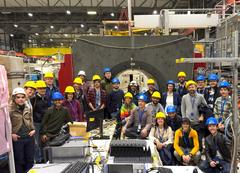The MADMAX team during tests at CERN. Image: MADMAX Collaboration
Dark matter is one of the most sought-after substances in the Universe. It would answer many open questions about the nature and rules of the Universe and elementary particle physics in one discovery. Many different experiments around the world are in on the chase, including the ALPS II experiment at DESY, which started taking data last year, and an experiment called MADMAX, which is in its prototyping phase. MADMAX, which stands for MAgnetized Disc and Mirror Axion eXperiment, has just reached several major milestones on the way to construction. The experiment aims at discovering dark matter particles called axions in a particular mass range in which theorists suspect axion dark matter got formed after the inflationary expansion phase which followed the Big Bang. MADMAX is an international collaboration of scientists, initiated and lead by researchers at the Max Planck Institute for Physics and was formally launched at DESY in 2017.
The idea is to install MADMAX in one of the underground experimental halls of the former HERA tunnel at DESY and see whether it can spot axions in a strong magnetic field through a telltale electromagnetic signal. With several prototypes and tests at different labs the collaboration is testing and demonstrating the experiment’s feasibility.
MADMAX relies on the principle that certain particles have the ability to take on the properties of other particles. In a static and strong magnetic field, an axion behaves a little bit like photons, inducing tiny electric-field oscillations. If the scientists would detect this electric field oscillation, they would verify the existence of dark matter axions. However, it’s not quite as easy as it sounds because any signal would be much, much too low for even the most sensitive detectors.
Their idea is therefore to boost the signal by confronting the axion with many carefully placed dielectric disks, which would cause the axion-induced electric-field oscillations to emit microwaves when they meet. These waves can be combined and reflected and thus amplified, and it’s these priciples, the detector and the magnet that the MADMAX collaboration put to the test.
The MADMAX collaboration has presented first results at the 97th DESY Physics Review Committee (PRC). Since the last review by the DESY PRC, the collaboration has conducted experiments with three prototypes which differ in complexity and for their increasing size, and have provided convincing answers for all major request of the reviewing board.
They used a three-disk ten-centimetre diameter prototype in a cryostat installed inside a 1.6-Telsa magnet at CERN, proving their ability to calibrate and operate detectors at 4 K temperature. They also tested a three-disk 20-centimetre diameter prototype in which the disk spacing can be adjusted inside the same magnet – thus checking whether the signal’s frequency can be tuned. They also took their first data of potential axion-like particles which are currently under analysis. Finally, they used a three-disk 30-centimeter diameter prototype in the Shielded Experimental Laboratory of Universität Hamburg, already setting competitive limits in the mass range around 80 micro-eV on dark photons, another dark-matter candidate. In other words: they have not detected any axions, but they know now how to look for them.
“Achieving these three major milestones clears the majority of open questions towards the experiment feasibility,” says Erika Garutti, chairperson of the collaboration board and spokesperson of the cluster of excellence Quantum Universe, which supports the experiment with significant investments in Hamburg.
“MADMAX has done impressive work, but searching for axions is also about the magnet,” said Yannis Semertzidis, member of DESY’s Physics Review Committee and director of the Institute for Basic Science Center for Axion and Precision Physics Research and a physics professor at the Korea Advanced Institute of Science & Technology (KAIST). The next challeng for MADMAX will be to procure a 9-Tesla large dipole magnet to increase the area of the detector, and thereby the sensitivity to axions to the requirements for detection. To facilitate progress on this task, the Max Planck Society has made available significant resources to produce and test a demonstrator magnet. The principle possibility to realise such a magnet has been demonstrated earlier by the collaboration.
The timescale of the experiment is 2032/2039. Provided funds become available, the magnet will be produced and tested in 2027/2032 and MADMAX scientists hope that they will take first data with full scale experiment in 2032.








